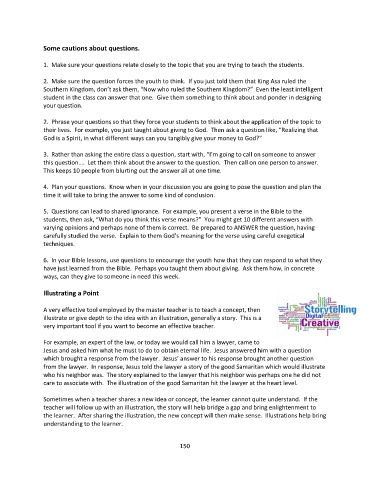Page 151 - Discipleship Ministries Student E-Book
P. 151
Some cautions about questions.
1. Make sure your questions relate closely to the topic that you are trying to teach the students.
2. Make sure the question forces the youth to think. If you just told them that King Asa ruled the
Southern Kingdom, don’t ask them, “Now who ruled the Southern Kingdom?” Even the least intelligent
student in the class can answer that one. Give them something to think about and ponder in designing
your question.
2. Phrase your questions so that they force your students to think about the application of the topic to
their lives. For example, you just taught about giving to God. Then ask a question like, “Realizing that
God is a Spirit, in what different ways can you tangibly give your money to God?”
3. Rather than asking the entire class a question, start with, “I’m going to call on someone to answer
this question…. Let them think about the answer to the question. Then call on one person to answer.
This keeps 10 people from blurting out the answer all at one time.
4. Plan your questions. Know when in your discussion you are going to pose the question and plan the
time it will take to bring the answer to some kind of conclusion.
5. Questions can lead to shared ignorance. For example, you present a verse in the Bible to the
students, then ask, “What do you think this verse means?” You might get 10 different answers with
varying opinions and perhaps none of them is correct. Be prepared to ANSWER the question, having
carefully studied the verse. Explain to them God’s meaning for the verse using careful exegetical
techniques.
6. In your Bible lessons, use questions to encourage the youth how that they can respond to what they
have just learned from the Bible. Perhaps you taught them about giving. Ask them how, in concrete
ways, can they give to someone in need this week.
Illustrating a Point
A very effective tool employed by the master teacher is to teach a concept, then
illustrate or give depth to the idea with an illustration, generally a story. This is a
very important tool if you want to become an effective teacher.
For example, an expert of the law, or today we would call him a lawyer, came to
Jesus and asked him what he must to do to obtain eternal life. Jesus answered him with a question
which brought a response from the lawyer. Jesus’ answer to his response brought another question
from the lawyer. In response, Jesus told the lawyer a story of the good Samaritan which would illustrate
who his neighbor was. The story explained to the lawyer that his neighbor was perhaps one he did not
care to associate with. The illustration of the good Samaritan hit the lawyer at the heart level.
Sometimes when a teacher shares a new idea or concept, the learner cannot quite understand. If the
teacher will follow up with an illustration, the story will help bridge a gap and bring enlightenment to
the learner. After sharing the illustration, the new concept will then make sense. Illustrations help bring
understanding to the learner.
150

